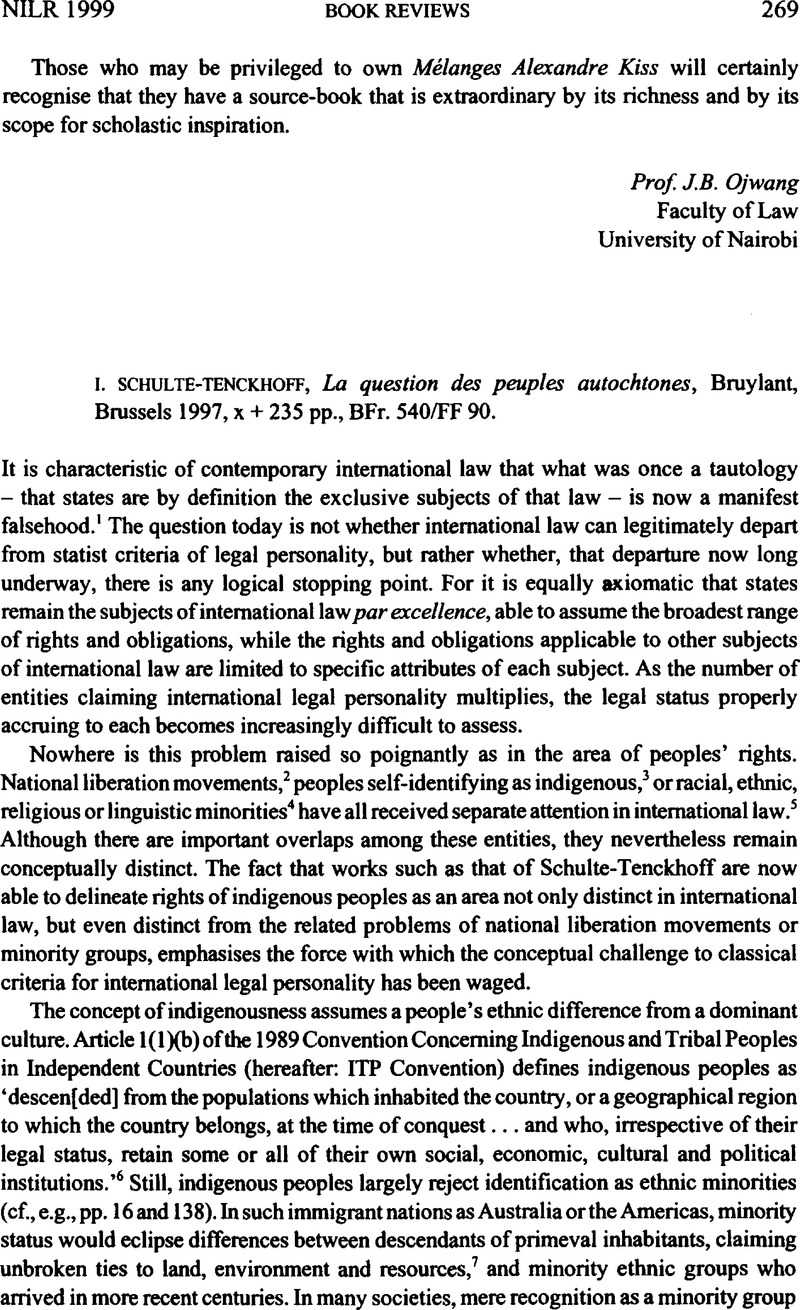No CrossRef data available.
Published online by Cambridge University Press: 21 May 2009

1. For a classic statement, see ‘Reparations for Injuries Suffered in the Service of the United Nations’, ICJ Rep. (1949) p. 174 (11 April). See also, e.g., Hailbronner, K., ‘Der Staat und der Einzelne als Völkerrechtssubjekte’, in Vitzthum, W. Graf, ed., Völkerrecht (Berlin, De Gruyter 1997) pp. 181, 188–204Google Scholar; Jennings, R. and Watts, A., Oppenheim's International Law, Vol. 1, 9th edn. (London, Longmann 1992).Google Scholar
2. See, e.g., Hailbronner, op. cit. n. 1, p. 196; Jennings and Watts, op. cit. n. 1, pp. 162–162; Nguyen Quoc Dinh, et al., Droit international public, 5th edn. (Paris, Librairie Générale de Droit et de Jurisprudence 1994) pp. 166–167,497–499.
3. In addition to the work reviewed here, see, e.g., Anaya, J., Indigenous Peoples in International Law (New York, Oxford University Press 1996)Google Scholar; Tenant, C., ‘Indigenous Peoples, International Institutions and the International Legal Literature from 1945 to 1993’, 16 Human Rights Quarterly (1994) pp. 1–57.CrossRefGoogle Scholar
4. See, e.g., Heinze, E., ‘The Construction and Contingency of the Minority Concept’, in Bowring, B. and Fottrrell, D., Minority and Group Rights in the New Millennium (The Hague, Kluwer Law International 1998) pp. 25–74, along with references cited therein.Google Scholar
5. See also Cassese, A., Self-Determination of Peoples: A Legal Reappraisal (Cambridge, Cambridge University Press 1995).Google Scholar
6. ILO Convention No. 169 (1989), reprinted in 34 ILM (1995) p. 535 (hereafter: ITP Convention).
7. Note, however, that such ties have in some cases been attenuated by internal displacements.
8. See Heinze, op. cit. n. 4, pp. 26–33 (noting the continuing dominance of individual rights over group rights).
9. See Nguyen Quoc Dinh, et al., op. cit. n. 2, pp. 500–501; Cassese, op. cit. n. 5, pp. 118–24.
10. See the Frontier Dispute case (Burkina Faso v. Mali), ICJ Rep. (1986) p. 554 (22 December). See also Nguyen Quoc Dinh, et al., op. cit. n. 2, pp. 492–512.
11. See Preambular para. 3 (affirming basic instruments of international human rights law), and Arts. 2(2)(a), 2(2)(b), 3(1), 8(2), 9(1), 24, 25(1), 26 (affirming civil, political, social, economic and cultural rights already part of the standard human rights corpus).
12. Preambular para. 4.
13. Part II (Arts. 13–19).
14. See Heinze, op. cit. n. 4, pp. 26–33, 40–43.
15. See supra text accompanying n. 6.
16. Postgate, J.N., Early Mesopotamia (London, Routledge 1992) p. 35.Google Scholar
17. Turnbull, S., Samurai Warriors (Poole, Blandford 1987) p. 83Google Scholar. See also, e.g., Simons, G., Iraq: From Sumer to Saddam (Houndmills, MacMillan 1994)CrossRefGoogle Scholar; Ratchnevsky, P., Inggis-Khan: Sein Leben und Wirken (Wiesbaden, Steiner 1983)Google Scholar; Shaw, J., History of the Ottoman Empire and Modern Turkey (Cambridge, Cambridge University Press 1976).CrossRefGoogle Scholar
18. Exodus 34:11–13.
19. See Barnett, H., Constitutional and Administrative Law, 2nd edn. (London, Cavendish 1998) pp. 54–58, 443–456.Google Scholar
20. See, e.g., Keeton, W.P., ed., Prosser and Keeton on Torts, 5th edn. (St. Paul, Minn., West Publishing Co. 1984) p. 635.Google Scholar
‘If a plaintiff comes to a “nuisance” in the sense that he comes to an area where the defendant has already been making a particular use of his property, such as for a feed lot, and then is allowed successfully to maintain a suit either for damages or for abatement of the nuisance, the court could quite frequently be in the position of giving the plaintiff a windfall capital gain to which he is not entitled, and at the expense of the defendant. Plaintiff would be in the position of having purchased at a depressed price because of the presence of the feed lot and then at a substantial expense to the defendant brought about an abatement, thereby increasing to a substantial extent the market value of the land.’
Note, however, that his doctrine is subject to important limitations, idem.
21. ITP Convention, Art. 14(1).
22. See, e.g., Jennings and Watts, op. cit. n. 1, pp. 698–705.
23. On comparable problems of essentialism in international human rights discourse, see Heinze, op. cit. n. 4, pp. 45–56; Heinze, E., ‘Discourses of Sex: Classical, Modernist, Post-Modernist’, 67 Nordic Journal of International Law (1998) pp. 37–76CrossRefGoogle Scholar; Heinze, E., Sexual Orientation: A Human Right (Dordrecht, Martinus Nijhoff 1995) ch. 2.Google Scholar
24. Cf., e.g., the Declaration on Race and Racial Prejudice, General Conference of the United Nations Educational, Scientific and Cultural Organization of 27 November 1978, Arts. 1(2), 5(1), 5(2), 5(3), 6(2), 8(2), 8(3), reprinted in United Nations Centre for Human Rights, A Compilation of International Instruments, Vol. 1 (New York, United Nations 1993) p. 140Google Scholar (confirming multi-racial diversity as a source of enrichment for all persons).
25. Nor is this problem unique to indigenous peoples. Minority rights, women's rights or rights of sexual minorities are other areas in which individual difference can upset comprehensive or programmatic agendas. The problem is well known: Who speaks for the group? See, e.g., works cited supra n. 23.